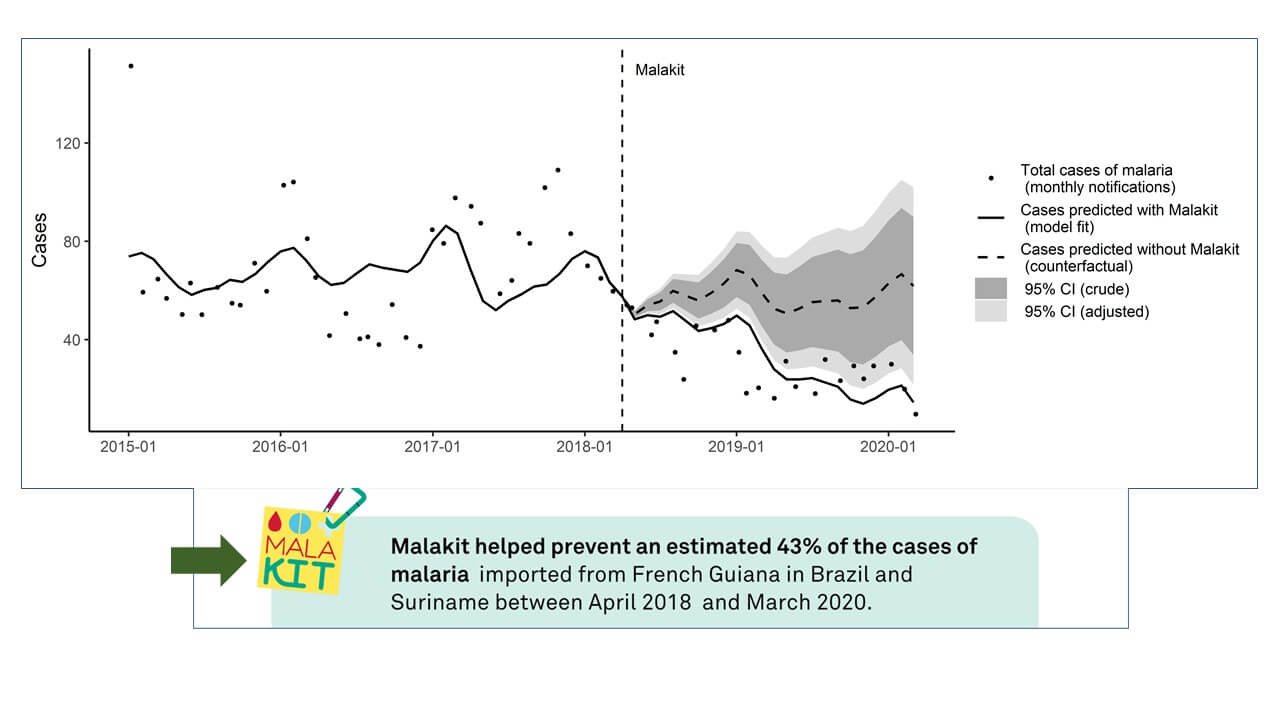The Malakit strategy has shown good acceptability by the gold miners population, an increase in the appropriate use of RDTs and treatments (ACT, artemisinin-based combination therapy), and a probable impact on malaria transmission.
During this 2-years pilot phase, 4,766 kits were distributed to 3,733 participants in the Malakit study.
Pre/post studies involved 1,098 patients.
Increase of appropriate malaria treatment
According to our before & after cross-sectional surveys (respectively called Orpal_1 and Orpal_2) the appropriate use of a test and treatment (by using a malakit or turning to the healthcare system) increased from 54.2% to 68.2% (OR=1.8, IC95% [1.1-3.0]).
A malakit was used by 37% of the 91 people with malaria symptoms since the beginning of the project. Of the 27 people who had self-medicated after the start of the Malakit project, six went then to a distribution site to take part in the study.
Treatment adherence was higher when the patient received care in a health center (91% [89-94]) or used a malakit (81% [67-96]) than with unregulated self-medication (65% [60-70]) (OR=5.4 [3.7-7.8]).
Good kit use
Of the 631 participants attending a longitudinal follow-up at Malakit inclusion sites, 223 participants reported having used a malakit: 71.7% [65.8-77.7] had used it correctly with either a complete treatment taken after a positive RDT or no treatment following a negative RDT.
In the subgroup of 166 participants with a positive RDT, 71.1% [64.2-798.0] had completed a full treatment course.
Good acceptance of the project
Of the 499 people included in Orpal_2, 320 (64%) had already heard about Malakit. Of the 320 people who had heard of Malakit, 147 (46%) had been included in the project. In all 29.8% of the 493 participants in the Orpal_2 studies were included in the Malakit project.
These data were confirmed by a qualitative study performed in 2019 by Pr André-Anne Parent from Montréal University. This study confirms that the study population considers malaria to be a major health problem and that the economic consequences of the disease are an important concern, with physical fitness being seen as an indispensable resource for gold-mining work and the income derived from it. The free distribution of malakits is considered to be the best solution against malaria, especially in opposition to medication accessible but costly in the forest.
The participants express a relationship of trust, even friendship, with the facilitators, builded and consolidated during the study period, in spite of some initial mistrust at first which dissipated quickly. According to the facilitators, the initial worry became less and less perceptible as the project progressed.
Probable impact on malaria prevalence
The cross-sectional Orpal studies evaluated the prevalence of Plasmodium in the population of gold miners working in French Guiana, using a species-specific PCR based on the Shokoples et al. technique.
It shows the clear decrease in prevalence of malaria in this population between 2015 (22.3% [18.3-26.3]) and 2019 (5.3% [3.0-7.5]) on the French-Surinamese border and less marked on the French-Brazilian border from 3.9% [1.0-6.8] in 2015 to 2.5% [0-5.3] in 2019.
Interrupted-time series modeling suggests that the implementation of Malakit has accelerated the decline in malaria in the region.
Safety of use
Few adverse events were reported without concern from the Data Safety Monitoring Board (DSMB).
Off-protocol kit circulation appeared to be limited.
Find all publications related to the project here.
This innovative international project shows that people with little education can be trained to self-care for malaria and change their behavior.
This strategy could be a new tool for malaria control in other regions facing a similar situation.





